A bed of rice, the bottom crisped up and nestled in a dolsot bowl, topped with various seasoned vegetables, tofu and a super yummy spicy gochujang Bibimbap sauce… This Korean mixed rice dish will have you craving it every single night of the week! And this bibimbap is vegan...
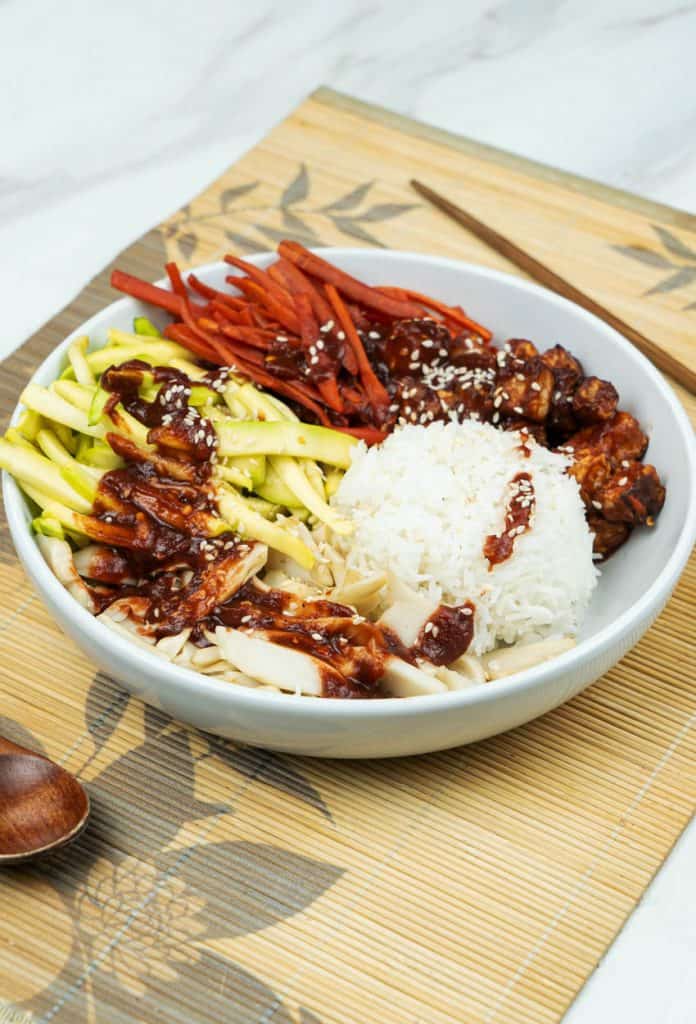
The best part? Making vegan Bibimbap at home is super easy. This recipe comes together pretty quickly. Plus, you can prepare most of the ingredients in advance. It’s a Korean classic packed with flavor and color, all in one bowl. And the health benefits… don’t get me started just yet.
If you’re ready to make your own vegan Bibimbap, keep reading! This blog post is a comprehensive guide to making it, its nutritional benefits, and more. So, let’s get started.
What Is Bibimbap?
At its core, Bibimbap (비빔밥, pronounced bee-bim-bahp) is a nourishing Korean rice dish. It literally means—bibim: mixed, and bap: rice. As such, Bibimbap translates to “mixed rice”. But that simple name barely scratches the surface of how satisfying (and beautiful!) this bowl can be.
Traditionally, Bibimbap brings together warm rice, an assortment of seasoned and sauteed vegetables (called namul), some protein (which, in the conventional version, would be beef or egg), and a generous dollop of gochujang, which is a spicy-sweet fermented chili paste. When you mix it all together, the end result is heavenly.
While classic versions often include animal products, vegan Bibimbap is just as authentic. By swapping in marinated tofu, mushrooms, or plant-based meat alternatives, and loading up on seasoned veggies, you get the same deeply comforting experience. And believe me when I say, there’s no compromise on the taste.
It’s the kind of meal that feels as good as it tastes: nourishing, colorful, incredibly satisfying.
What makes Bibimbap unique is its variations. You can say it’s one of the things I find the most fun to make and eat. The recipe I’m sharing today is my vegan take on Bibimbap with classic toppings that you’d most likely find at a restaurant (but without meat or eggs).
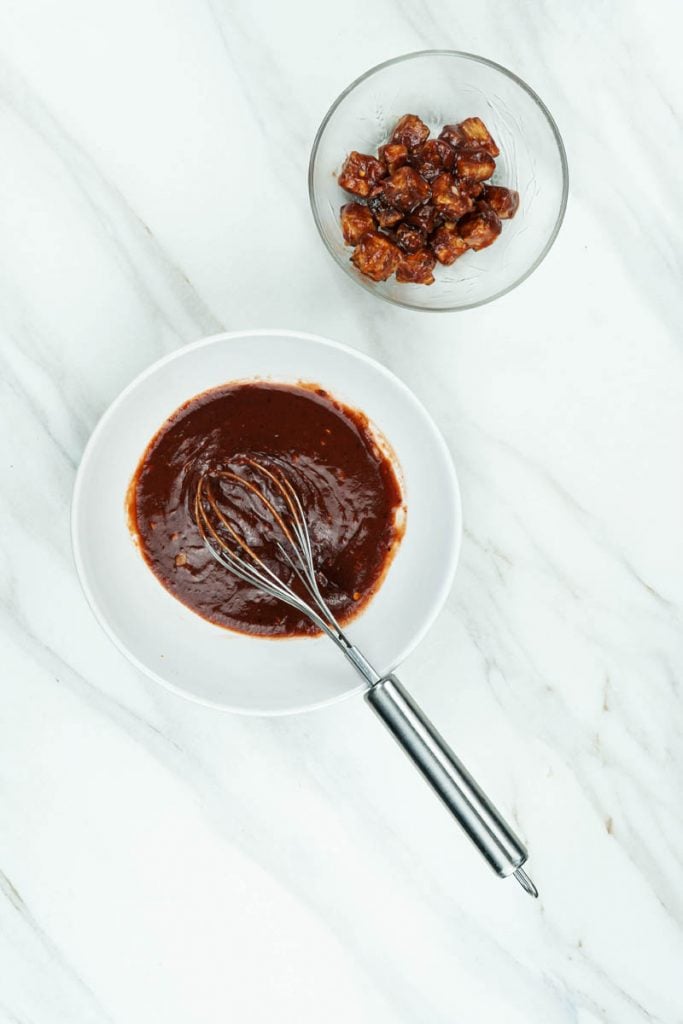
Why You’ll Love Vegan Bibimbap
Vegan Bibimbap is quite the dish that checks all the boxes…
- Flavorful ✅
- Filling ✅
- Beautiful ✅
- Good for you ✅
So you can expect it to deliver every time. Here’s why it deserves a (permanent) spot on your recipe rotation.
It’s Nutritious
Bibimbap is a wellness bowl, considering it has plenty of vegetables, fermented goodies (like kimchi) and protein-packed additions like tofu. It’s full of fiber, antioxidants, and plant-based protein. All of these work together to nourish your body. Stay tuned till the end of the post to learn about the health benefits of this dish.
A Good Balance
If you’ve been thinking of Bibimbap as a pile of veggies over rice… Well, you’re right, but only partially. Complex carbs from rice; plant protein from tofu; healthy fats from sesame oil and seeds; sauteed veggies for crunch—it’s actually a great balance! Every bite will hit the sweet spot between comforting and clean 😌
Super Customizable
Gluten-free? Swap in tamari and rice. Soy-free? Skip the tofu and go with lentils or roasted chickpeas. Low-carb? Cauliflower rice will work. Bibimbap is super adaptable to your lifestyle as well as dietary needs, and will still be delicious every time.
Fun and Gorgeous
There’s something joyful about building a Bibimbap bowl. Each ingredient has its place. You know, like colors on a painter’s palette. Whether you’re prepping lunch or entertaining guests, it’s a dish that feels just as fun to make as it is to eat. And it always looks Instagram-worthy.
Ingredients Overview
So, what ingredients go into the making? Let’s find out everything you’ll need for vegan Bibimbap, along with their benefits.
Sushi rice, cooked. This is short-grain rice that is sticky and soft, primarily why it’s great for mixing in the bowl. Sushi rice holds the dish together beautifully and also provides a neutral base that absorbs all the flavorful toppings.
Marinated tofu. Tofu is a wonderful protein that absorbs lots of flavor. For this recipe we use store bought, but if you have the time, we do have a great teriyaki tofu marinade that can be used here.
Carrots, cut into sticks. Sauteed or lightly steamed, carrots bring crunch to your bowl. I personally love the slight sweetness they add. Carrots are loaded with beta-carotene (a precursor to vitamin A). This promotes healthy skin, vision, and immunity.
Zucchini, cut into sticks. Zucchini has a delicate and slightly sweet flavor. When you saute zucchini sticks, you’ll notice they develop this soft texture, which nicely balances the other (crunchy) toppings. Zucchini has plenty of antioxidants like lutein. Plus, it’s a low-calorie source of hydration and vitamin C.
Shiitake mushrooms, sliced. These are earthy and meaty, so they can bring a savory flavor to the dish. Shiitake mushrooms have some amazing immune-boosting properties. Additionally, they give your body vitamin B and can lower cholesterol.
Garlic cloves, minced. These are used to flavor vegetables during sauteing. Garlic brings a beautiful aroma to the dish.
Low-sodium soy sauce. This gives a salty taste to the seasoned vegetables. It still lets their individual flavors shine, too, though. A low-sodium choice keeps your bowl heart-friendly.
Sesame oil. Used for seasoning and sauteing, sesame oil adds a rich and toasty finish to the vegetables. Sesame oil contains healthy fats and antioxidants like sesamin, which may help reduce inflammation in the body.
For the Vegan Gochujang Sauce…
Gochujang (Korean red chili paste). This is gonna give us the signature Bibimbap flavor: sweet, spicy, fermented, and complex. Such fermented foods can help with gut health and digestion.
Garlic clove, minced. This complements the fermented notes of gochujang.
Sugar. This balances the heat and acidity of the sauce. You can substitute it with maple syrup or coconut sugar.
Soy sauce. Enhances the umami factor.
Vinegar (rice or white). Brings brightness and tanginess to the bowl. Healthwise, vinegar can help balance your blood sugar levels.
Sesame seeds. A final sprinkle on top of your bowl will add texture. Small but mighty, sesame seeds are packed with calcium, healthy fats, and plant-based protein.
How to Make Vegan Bibimbap
Now that you have the ingredients at hand, let’s walk through the steps that will bring together this vegan Bibimbap bowl.
Cook the Rice
Start by cooking your rice according to the package instructions. If you have a rice cooker, even better 😊 Just let the rice stay warm while you prep the rest.
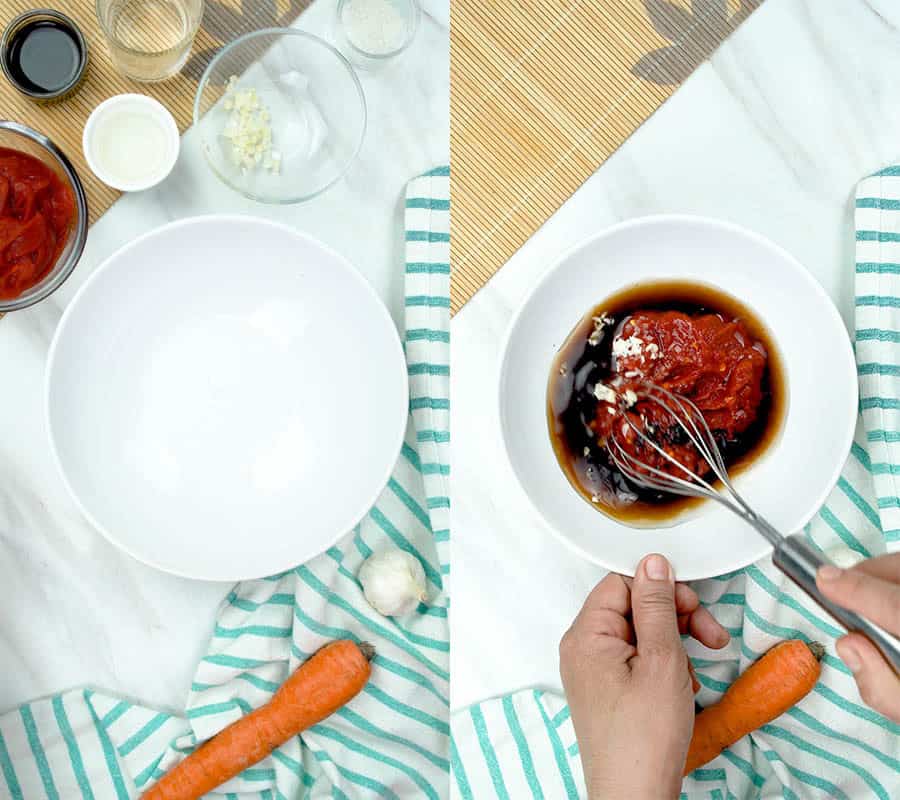
Make the Vegan Bibimbap Sauce
In a medium bowl, whisk together:
- ¼ cup gochujang
- 2 tablespoon mirin
- 1 garlic clove, minced
- 1 tablespoon sugar
- 2 teaspoon soy sauce
- 2 tablespoon rice vinegar or white vinegar
Stir it all until the sugar dissolves and the sauce looks smooth and glossy. You can taste it and then adjust it as needed. For example, add some more sugar for sweetness or vinegar for tang.
Prep Your Ingredients
Prep your ingredients as stated in the ingredients list. Slice those mushrooms, carrots, and zucchini. Mince the garlic then get the marinated tofu chopped and ready to sear.
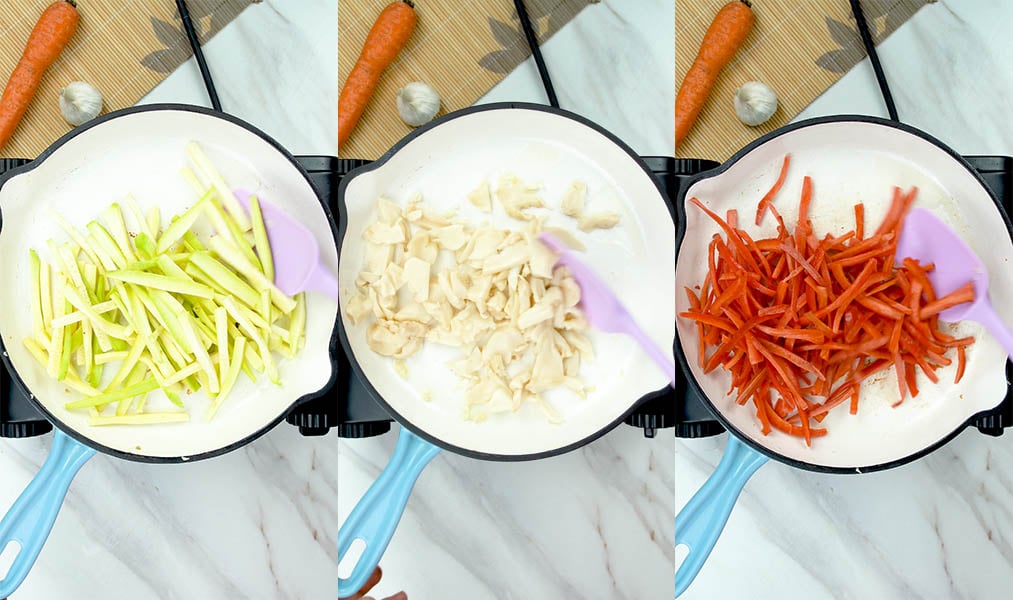
Cook the toppings
You will be cooking each topping separately to preserve its unique flavor. Use a non-stick skillet over medium heat.
Mushrooms:
- Use 1 tablespoon avocado oil. Once hot, add mushrooms and cook for 2 to 3 minutes.
- Next add half the minced garlic and 1 teaspoon low sodium soy sauce. Stir well.
- Cook until tender, then remove to a plate.
Zucchini:
- Use 1 teaspoon oil in the skillet.
- Add zucchini and cook it for 3 to 4 minutes. Occasionally stir it.
- Transfer to a plate once lightly golden and tender.
Carrots:
- Add 1 teaspoon oil.
- Cook carrots for 5 to 7 minutes until just tender, stirring a few times.
- Remove to a plate.
Marinated tofu:
- Use 1-2 teaspoon oil
- Add tofu over medium-high heat for 3-5 minutes, flipping once.
- Remove to a paper towel lined plate ultimate crispness! .
Assemble the Bowls
Here comes the fun part…
- Scoop 1 cup of cooked rice into each bowl.
- Arrange your cooked veggies in neat sections on top: mushrooms, carrots, zucchini, spinach, and bean sprouts.
- Pile on some spicy marinated tofu
- Drizzle a (generous) spoonful of Bibimbap sauce over it all.
- Sprinkle with toasted sesame seeds.
Optionally, you can add on sliced avocado, nori strips, or a vegan fried egg on top.
Pro Tips
If it’s your first time making vegan Bibimbap (or you’re looking to master the recipe), here are expert tips to make the dish:
- Don’t overcrowd the pan. Cook each vegetable separately in batches. Crowding them can give you soggy and bland veggies.
- Season as you go. Lightly season the mushrooms, sprouts, and greens with garlic, soy sauce, or sesame oil. This adds flavors.
- Use day-old rice (or keep it fresh and warm). Bibimbap works great with freshly steamed rice, but day-old rice (especially if pan-fried for a crispy bottom like in dolsot Bibimbap) makes the dish so textured.
- Prep veggies ahead of time. Want a faster weeknight dinner? Slice and store your veggies in containers a day in advance. You can also blanch the spinach and sprouts early and then refrigerate them.
- Mix it just before eating. Bibimbap is all about the final stir. Mix everything together just before you eat it to coat the ingredients in the gochujang sauce.
Variations and Substitutions
There are so many variations you can try for the vegan Bibimbap recipe! That’s actually one of my favorite parts about it.
Swapping the Vegetables
No need to stick rigidly to zucchini and carrots. Use what you have or love most 😊 Instead of spinach, try bok choy, kale, or Swiss chard. You can replace your mushrooms with oyster, cremini, or even portobello slices. Alternatively, you can add in some extra items. Try shredded purple cabbage, edamame, roasted sweet potatoes, or bell peppers. They add to the taste + the nutrients!
Soy-Free Options
If you’re avoiding soy:
- Swap soy sauce with coconut aminos. You can also use tamari to make it gluten-free.
- Use chickpeas or lentils instead of tofu.
- Skip gochujang and try a homemade chili paste with miso-free chili flakes, vinegar, maple syrup, and garlic.
Bento or Bowl?
You can even repurpose your Bibimbap ingredients into something more fun. Like a bento box lunch (with separated toppings). Or added into wraps or lettuce cups for a low-carb finger food option.
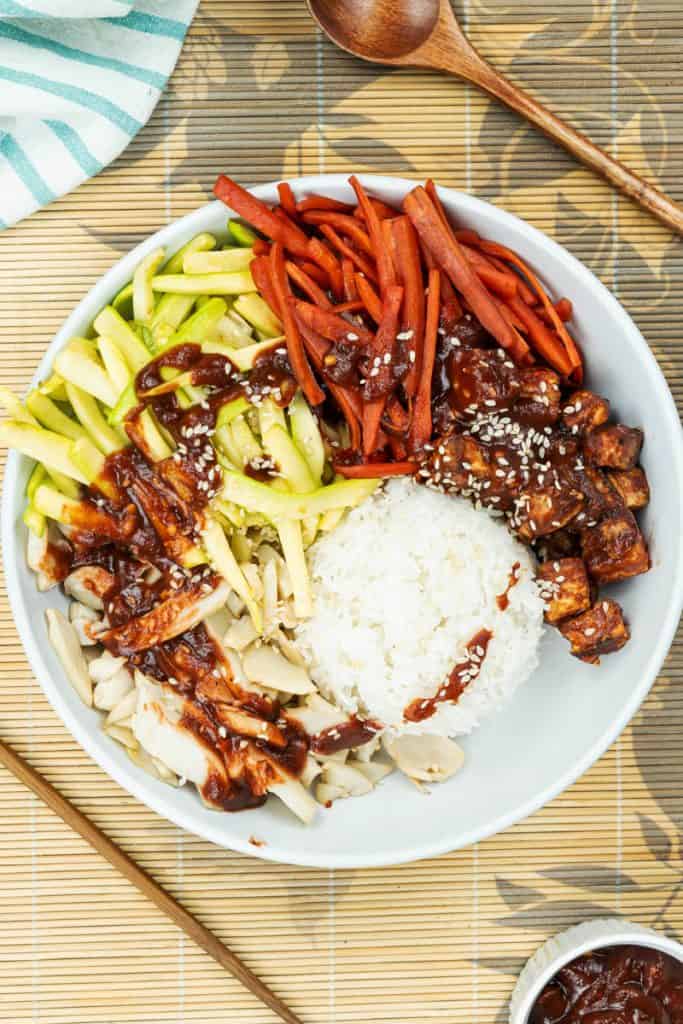
Health Benefits
Now that you know how to make your very own vegan Bibimbap, let’s wind up by sharing some of its health benefits. Yep, it’s as nourishing for the body as is beautiful for the eyes!
Packed with Nutrients
Each colorful topping in Bibimbap brings its own nutrients for your body…
- Carrots offer beta-carotene for eye and skin health.
- Spinach delivers iron, folate, and magnesium for energy.
- Zucchini is rich in vitamin C and hydrating fiber.
- Bean sprouts provide vitamin K and enzymes that help with digestion.
- Mushrooms support immunity and have plenty of B vitamins.
Balanced Macros
A good Bibimbap bowl hits all the major macronutrients:
- Complex carbs from rice provide slow-burning energy.
- Healthy fats from sesame oil and seeds help with hormone regulation.
- Plant-based proteins (from tofu, mushrooms, or sprouts) support muscle repair and keep you feeling full.
Great for Gut Health
Ingredients like bean sprouts and spinach are rich in fiber and/or probiotics, which promote digestion. They also feed good gut bacteria and help reduce bloating.
It’s Heart-Healthy
We’re skipping animal products and going for nutrient-dense veggies and oils. This means vegan Bibimbap keeps saturated fat low. It also offers heart-friendly ingredients like avocado oil and leafy greens.
Naturally Anti-Inflammatory
We add antioxidant-rich veggies, garlic, and fermented chili paste to our Bibimbap. This means it can help our body fight oxidative stress and inflammation (which are two root causes of chronic illnesses).
Final Words
And, that’s a wrap! I hope you know all about making your own vegan Bibimbap. Get ready… It’s not only going to taste good; it’s also gonna feel good 😋
More Recipes you might like...
more rice bowl recipes to think about
- Vegan fried rice with tofu
- One pot teriyaki tofu and rice
- Garliky brown rice pilaf
- Wild rice stuffed acorn
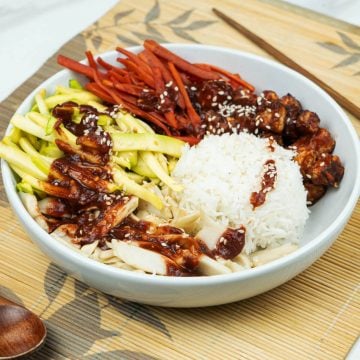
Vegan Bibimbap bowls
Equipment
- 1 skillet
Ingredients
- 4 cups short grain rice sushi or Cal-rose; cooked
- 1 package marinated tofu or
homemade - 2 large carrots cut into sticks
- 2 zucchini cut into sticks
- 8 oz mushrooms sliced
- 1 garlic clove minced
- 1 teaspoon soy sauce low sodium
- ¼ teaspoon sugar
- Sesame oil
FOR THE SAUCE
- ¼ cup gochujang
- 2 tablespoon mirin
- 1 garlic clove minced
- 1 tablespoon sugar
- 2 teaspoon soy sauce
- 2 tablespoon vinegar rice or white
- Sesame seeds
Instructions
- Start by cooking your rice according to package instruction. Keep warm if using a rice cooker.
- Next slice your mushrooms, carrots, and zucchini. Chip the spinach and Mince your garlic.
BIBIMBAP SAUCE
- Mix all the sauce ingedients in a medium bowl. Make sure the sugar has dissolved and the sauce looks nice and smooth.
COOK THE TOPPINGS
- Heat a skillet over medium heat. Add 1 tablespoon of Avacado oil followed by the mushrooms. Cook for 2-3 minutes then add half the minced garlic and 1 teaspoon of soy sauce. Stir well then remove to a plate.
- Add another teaspoon of oil, then cook zucchini for 3-4 minutes. Stir a few times while cooking to evenly cook them. Remove to plate.
- Add a teaspoon more oil and cook the carrots until just tender (5-7 minutes). Remember to stir a few times. Remove to plate.
- Lastly add 1-2 teaspoon of oil to sear off the marinated tofu in the same skillet. Turn heat to medium-high and cook for 3-5 minutes total, flipping once. Remove to a paper towel lined plate to keep it crispy.
ASSEMBLY
- Start by adding 1 cup of rice to a bowl. Carefully place your toppings around the bowl, keeping them separate. Top with bibimbap sauce and sesame seeds. Repeat with remaining bowls.


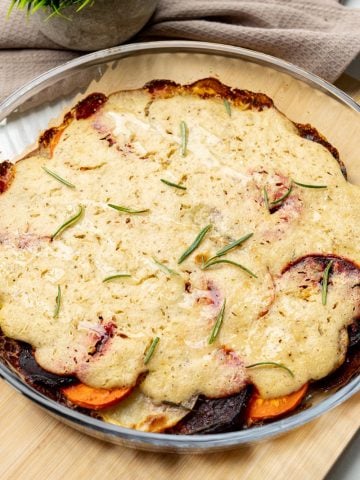
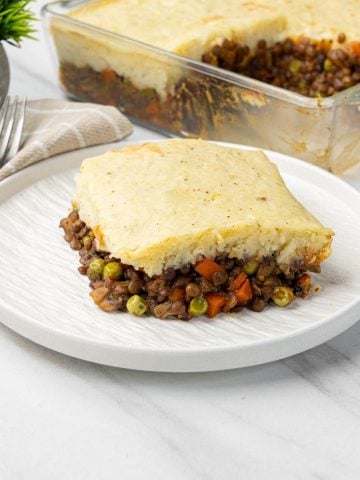
 Hi, we’re Shayne and Kristina! I’m the chef and editor here at My Darling Vegan, and Kristina is the photographer and writer. Together we’re carrying on this space with the same focus on easy, flavorful vegan recipes that anyone can enjoy at home. Check out our
Hi, we’re Shayne and Kristina! I’m the chef and editor here at My Darling Vegan, and Kristina is the photographer and writer. Together we’re carrying on this space with the same focus on easy, flavorful vegan recipes that anyone can enjoy at home. Check out our
Leave a Reply